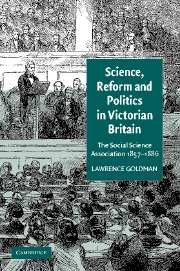Book contents
- Frontmatter
- Contents
- List of illustrations
- Acknowledgements
- Note on citations in the text
- List of abbreviations
- Introduction: the contexts of the Social Science Association
- Part I POLITICS
- Chapter 1 The origins of the Social Science Association: legal reform, the reformation of juveniles, and the property of married women in ‘the Age of Equipoise’
- Chapter 2 The Social Science Association and the structure of mid-Victorian politics
- Chapter 3 Organising the Social Science Association
- Part II REFORM
- Part III SCIENCE
- Part IV DECLINE
- Conclusion: The Social Science Association and social knowledge
- Appendix I The founders of the Social Science Association, 29 July 1857
- Appendix II Social Science Association Congresses, 1857–1884
- Appendix III Presidents of the Social Science Congresses, 1857–1884
- Appendix IV Departmental presidents, 1857–1884
- Select bibliography
- Index
Chapter 3 - Organising the Social Science Association
Published online by Cambridge University Press: 22 September 2009
- Frontmatter
- Contents
- List of illustrations
- Acknowledgements
- Note on citations in the text
- List of abbreviations
- Introduction: the contexts of the Social Science Association
- Part I POLITICS
- Chapter 1 The origins of the Social Science Association: legal reform, the reformation of juveniles, and the property of married women in ‘the Age of Equipoise’
- Chapter 2 The Social Science Association and the structure of mid-Victorian politics
- Chapter 3 Organising the Social Science Association
- Part II REFORM
- Part III SCIENCE
- Part IV DECLINE
- Conclusion: The Social Science Association and social knowledge
- Appendix I The founders of the Social Science Association, 29 July 1857
- Appendix II Social Science Association Congresses, 1857–1884
- Appendix III Presidents of the Social Science Congresses, 1857–1884
- Appendix IV Departmental presidents, 1857–1884
- Select bibliography
- Index
Summary
The Association's organisational history falls into two phases: an initial term of spectacular success, during which it functioned according to decisions taken at its inception, and a longer period after reorganisation in 1862–4 during which its structures altered little.
The SSA was initially based in offices in Waterloo Place, Pall Mall, and was governed by a council that comprised the President, Brougham, officers of the Association, and sixty members elected annually. The system was altered in 1862. The council was then enlarged to include representatives of each of the departments into which it was divided, and ‘every member of either House of Parliament who is also a member of the Association’. This resulted in a council of around 250 members which met four times a year. Day-to-day business was taken by an executive committee of twenty.
The early 1860s also saw changes to the departmental structure. The Association was originally organised into five departments: Jurisprudence and Amendment of the Law; Education; Punishment and Reformation; Public Health; and Social Economy, concerned with ‘questions relating to Capital, Labour and Production’. The Education and Public Health Departments were unaltered for the duration of the Association. But after the 1863 congress, crime and punishment were absorbed into Jurisprudence, where they formed one of three sections alongside international and municipal law.
- Type
- Chapter
- Information
- Science, Reform, and Politics in Victorian BritainThe Social Science Association 1857–1886, pp. 85 - 110Publisher: Cambridge University PressPrint publication year: 2002



